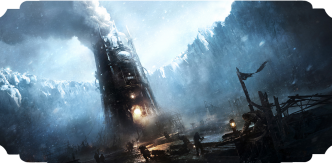| The Generator |
|---|

| |
| Details | |
| Build time | varies |
|---|---|
| Base Heating Level | 1-4 |
| Cost | |
| 68 | |
| 60 | |
| 45 | |
"As long as the Furnace was lit, there was hope."
The Generator is the most important building of the City in Frostpunk, as well as one of two buildings your city starts with, the other being Stockpiles. It is the main source of heat and power for your city and its people. The Generator will consume 6 coal per hour (144/day) at its base level (Steam level 1 and Range 1).
Description
The Heat Generator Tower, or Generator for short, is an enormous steam-powered furnace/engine that is the main source of Heat and Power in your City. Many of your Buildings require heat and power to keep them operational. Buildings that are further away from the Generator require Roads, which hold steam pipes and electrical cables, in order to function. The Generator also works in conjunction with Steam Hubs. When powered by the Generator, these contraptions create additional smaller Heat Zones around them. It also serves as a refuelling station for Automatons, unless there are any Steam Hubs closer by.
Keep it fed with Coal to stay on and keep your people warm. And if the Generator is destroyed… Then, everything is lost…
Lore
According to in-game Lore, when the Great Frost first was setting in, the United Kingdom and several other countries sent out expeditions to the North to find out what was going on. Many of these research outposts were equipped with Heat Generator Towers for long-term study to discover what caused this phenomenon.
Levels
The Generator has 4 levels. With each progressive steam level, more coal is required, but the heat level of all heat zones will increase. The Overdrive toggle makes the Generator run hotter (+1 heat level, or +2 if Overdrive Couplings has been researched), but this causes the Generator to accumulate stress, which can cause it to explode if it reaches maximum critical level. Stress builds up slower and falls quicker with the Generator Safety Bypass technology.
Changing the heat level causes Steam Hubs to consume more coal, just like the Generator does.
| Steam level | Temperature bonus in all heat zones |
Coal consumption at range 1 | ||
|---|---|---|---|---|
| Multiplier | Hourly | Daily | ||
| 4 | +4 | ×4 | 24 | 576 |
| 3 | +3 | ×3 | 18 | 432 |
| 2 | +2 | ×2 | 12 | 288 |
| 1 | +1 | ×1 | 6 | 144 |
| Shut down | +0 | ×0 | 0 | 0 |
Increasing the generator range also increases coal consumption. The following tables details hourly and daily consumption for all generator levels and ranges (before efficiency techs are researched).
Hourly
| Level → Range ↓ |
1 | 2 | 3 | 4 |
|---|---|---|---|---|
| 1 | 6 | 12 | 18 | 24 |
| 2 | 12 | 24 | 36 | 48 |
| 3 | 18 | 36 | 54 | 72 |
| 4 | 24 | 48 | 72 | 96 |
Daily (24h)
| Level → Range ↓ |
1 | 2 | 3 | 4 |
|---|---|---|---|---|
| 1 | 144 | 288 | 432 | 576 |
| 2 | 288 | 576 | 864 | 1152 |
| 3 | 432 | 864 | 1440 | 1728 |
| 4 | 576 | 1152 | 1728 | 2304 |
Events
The following Events are associated with the Generator.
The Generator
This arc is mostly information about the Generator and its use of overdrive, however also includes potentially game ending decisions.
Gallery
Overdrive
Generator stress level increases by 4% per hour when the overdrive is on. It decreases by 2% per hour when the Generator is running normally, or when it is shut down. When the stress level reaches 100%, the Generator explodes and the game ends.
Overdrive doesn't consume any additional coal per hour. It simply increases the existing heat zone temperature by 1 level at the cost of stressing the Generator into failure. Overdrive can be seen as a way to save coal and should be used whenever the stress is at 0%; otherwise, usage time, or coal is being wasted.
Overdrive is better used when there are more steam hubs operating and when the generator range is extended. This will tend to be during the day when there are more steam hubs running.
Heavy overdrive usage should be saved for when the temperature will drop. You can overdrive for 24 hours without Generator Safety Bypass, 33 hours with Generator Safety Bypass. You can use this window of time to upgrade generator power generation. Dissipating 99% stress level takes 48.5 hours without Generator Safety Bypass, 39.5 hours with Generator Safety Bypass.
The first time the Generator stress level reaches 100% the game will not end immediately and will give the player a choice to either sacrifice a Steam Core or children, both of these will decrease stress level to around 75%. The player can also choose to let the generator explode and lose the game. The second time it will explode, not giving the usual warning at 95%. Be careful at this stage.
The Generator takes 45 minutes to increase its temperature by one level, but Overdrive-induced heat is applied instantly.
Trivia
- In the early concept art for Frostpunk, the Land Dreadnought appears to be a mobile version of a Heat Generator Tower or early Generator prototype.
- Numbered Generators are:
- Generator 623 - A New Home and Crater
- Generator 614 - The Arks and Frozen Grove
- Generator 014 - The Refugees and Snowdrifts
- Generator 157 - The Fall of Winterhome and Hanging Rock
- Generator 113 - The Last Autumn
- Generator 049 - Crags
- Generator 266 - Rifts
- Generator 358 - Canyon
- There are also other known generator numbers, namely Site 107 and Site 120. However those were not finished for one reason of another.
- In the DLC The Last Autumn, one can see that the generator is actually much bigger than it appears, having a very deep underground part. During an event in this same DLC, one can assume that the generator uses geothermal heat.
- Since the generator still requires coal to operate, it is likely not a pure geothermal generator but rather a form of coal-powered, steam-based geothermal heat pump, which pumps water into the ground where it is heated geothermally, heat that can then be extracted with a heat exchanger and used for a wide range of applications.







